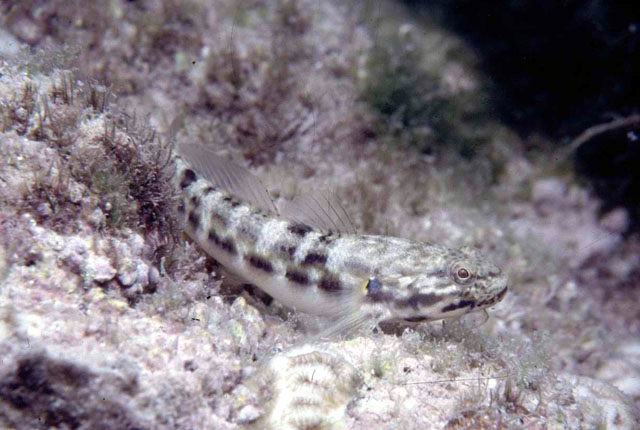| Gobiidae (Gobies), subfamily: Gobiinae |
| 6.6 cm TL (male/unsexed) |
|
demersal; brackish; marine |
| Eastern Atlantic: Mauritania to Angola (Ref. 57403, 79590), including the islands of the Gulf of Guinea (Ref. 5299, 79590). Also known from Cape Verde (Ref. 5299). |
|
Dorsal spines (total): 7-7; Dorsal soft rays (total): 9-11; Anal spines: 1-1; Anal soft rays: 8-10. Diagnosis: body with 3 longitudinal dark bands, no pale striae along sides; head and bases of pectoral fins without pale spots; predorsal scales extend anteriorly to level of preoperculum or only just anterior to this, and the anterior margin of scaled area weakly emarginate in dorsal view; 3-4 outer/upper free pectoral-fin rays (Ref. 57403, 79590).
Description: 14-21 (usually 17 or 18) predorsal scales; 34-39 (usually 36 or 37) scales in longitudinal series (including usually 2 scales on caudal fin base), 12 or 13 in rearward transverse series; 1st dorsal fin: VI; 2nd dorsal fin: I,9-11 (usually 10); anal fin: I,8-10 (usually 9); pectoral fins: 17-19 (usually 18), the 3-4 outer (dorsal) ones free; caudal fin: 14 or 15 branched rays (Ref. 57403, 79590).
Coloration: 3 longitudinal dark bands on body: lower one along the mid-lateral line, intermediate band along dorso-lateral part of flank, continuing anteriorly along the oculo-scapular groove (above dorsal margin of opercle and preopercle), and upper band fainter, running along bases of dorsal fins and continuing forward on nape; faint longitudinal bands running from posterior border of eye to toward mid- and upper part of preoperculum, meeting dark spot on mid part of operculum, and fainter spot on upper part of operculum; dark suborbital band from corner of mouth to midway along cheek, level with posterior part of iris; lower jaw with pale spots; broad dark spot on upper margin of pectoral-fin base, posterior to upper corner of operculum; upper and lower margins of pectoral-fin bases with narrow longitudinal bands; dorsal fins each with a narrow, dark longitudinal band at base; 2nd dorsal fin speckled on mid and dorsal parts of fin, but with a pale distal margin; anal fin dark on distal parts, but with a pale margin; pelvic fins dark; caudal fin with dorsal and ventral areas dark and a short oblique line on upper part of base (Ref. 57403, 79590). |
| Marine species, inhabiting the intertidal zone and entering brackish waters (Ref. 57403, 79590), occasionally found in lagoons (Ref. 4343). Found in intertidal rock pools and mudflats at high tide (Ref. 5299). Maximum reported total length 8.1 cm (Ref. 57403, 79590). |
|
Least Concern (LC); Date assessed: 15 July 2014 Ref. (130435)
|
| harmless |
Source and more info: www.fishbase.org. For personal, classroom, and other internal use only. Not for publication.
